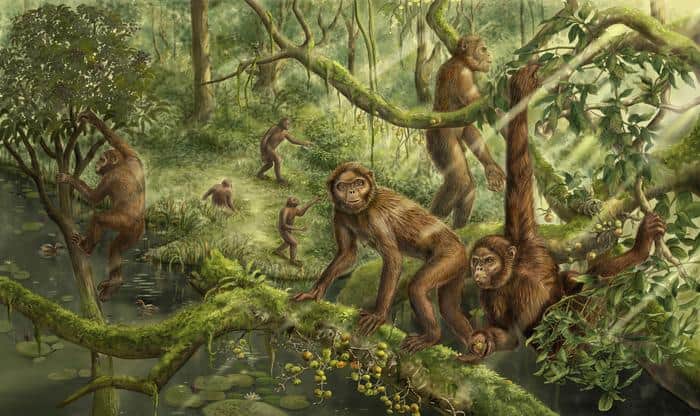
There haven’t been too many animals to walk on two legs. Apart from humans, the only other bipedal animals are birds, some lizards and, oddly enough, cockroaches (when they move very fast). Kangaroos? They just hop bipedally, like some rodents and birds, but when they walk it’s not on two legs.
The mandatory bipedalism that characterizes humans is unique among living primates and is exceedingly rare in the animal kingdom. Yet, despite the fact that transitioning from climbing trees to walking upright was a huge evolutionary milestone for our lineage, scientists are still not sure how exactly all of this happened.
There are some clues, of course. By comparing the limb, shoulder, pelvis, and spine bones of our early ancestors, it is possible to ascertain when key evolutionary jumps conducive to upright walking occurred. These are all bones strongly connected to upright movement. However, there’s another set of bones that has nothing to do with your limbs but which is nevertheless critical to walking: the bones of your inner ear.
Playing it by ear
Deep within the skull, between our brains and external ears, lie the semicircular canals. These structures are key to our balance and understanding our position as we move. They’re like an internal gyroscope, helping us to navigate the world on two feet, a feature most of us take for granted.
Researchers at the University of York and the Chinese Academy of Sciences used advanced 3D CT scanning to analyze the bony inner ear of the 6-million-year-old fossil ape Lufengpithecus. By measuring their exact shape, it is possible to tell what kind of body posture our ancestors used to move about.
“The size and shape of these canals correlate with movement. By studying them, we can infer how extinct mammals, including our ancestors, moved,” said Yinan Zhang, a doctoral student at the Institute of Vertebrate Paleontology and Paleoanthropology of the Chinese Academy of Sciences (IVPP).

Lufengpithecus is a genus of extinct apes, which roamed the Earth millions of years ago during the Miocene epoch. Unlike the well-known African apes like Australopithecus, Lufengpithecus is regarded as a different branch of the primate family tree. This means it plays a crucial role in filling gaps in our evolutionary timeline.
When the first remains were discovered in China’s Yunnan Province in the early 1980s, the skulls were rather distorted. Researchers didn’t think that the delicate inner ear bones would be preserved because of this. However, with advanced 3D CT scanning, scientists have been able to virtually reconstruct these canals, offering unprecedented insight into how these ancient apes moved.
New ways to move
After comparing these scans with those belonging to other living and fossil apes, as well as humans from Asia, Europe, and Africa, the researchers outlined a “three-step evolution” of human bipedalism.
It begins with early apes moving in trees like today’s gibbons. Then, our last common ancestor with apes, akin to Lufengpithecus, used a mix of climbing, clambering, and even walking on two legs in trees, as well as walking on all fours on the ground. The last and final step is bipedalism, which evolved from this broad ancestral heritage.
Traditionally, scientists have focused on limb, shoulder, pelvis, and spine bones to understand locomotion. However, the diversity in living apes and the incomplete fossil record have made it challenging to piece together our bipedal origins. By turning to the inner ear, researchers have now opened a new window into understanding how our ancestors moved.
Professor Xijun Ni, who led the project at IVPP, remarks, “The inner ear provides a unique record of the evolutionary history of ape locomotion, offering an invaluable alternative to studying the postcranial skeleton.”
The study also suggests that climate change played a significant role in the evolution of movement in apes. “Cooler global temperatures, associated with the build-up of glacial ice sheets in the northern hemisphere approximately 3.2 million years ago, correspond with an uptick in the rate of change of the bony labyrinth and this may signal a rapid increase in the pace of ape and human locomotor evolution,” explained Terry Harrison, a New York University anthropologist and co-author of the paper.
As we tread the path of our daily lives, perhaps we can spare a thought for those ancient ancestors, whose evolutionary journey has led us to where we stand today—on two feet.
The findings appeared in the journal The Innovation.


